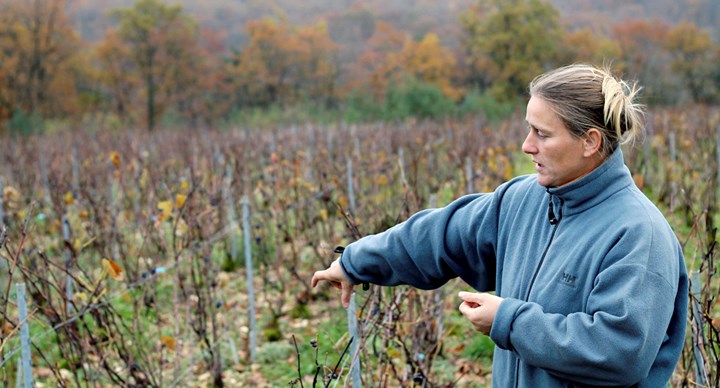
Which site would you like to visit?
By clicking the retail or wholesale site button and/or using rarewineco.com you are choosing to accept our use of cookies to provide you the best possible web experience.

The Aube is Champagne’s frontier, the place where a new generation of vignerons are pursuing unique visions of how to express their terroirs, unconstrained by conventional wisdom.
The embodiment of this pioneering spirit can be found in Gerard Ruppert and his daughter Benedicte Leroy. Their magical Champagnes are the result of a special site, farmed organically for the past thirty years, and methods developed through a strong empirical sense and the courage to experiment.
The Ruppert-Leroy farm lies at the southeastern limit of the appellation, outside the small village of Essoyes, just five kilometers from the border with the Côte d’Or. Literally in the middle of nowhere, it is about as far from Reims and its big houses as a Champagne producer can be. Much of the fruit produced here is sold to the local cooperative or very quietly to the Marne’s grandes marques.
Yet, if there is any place in the Aube that is best suited for the “Burgundy with bubbles” philosophy of the region’s best growers, it is here. And that ethos is exemplified by the striking terroir expression of Ruppert-Leroy’s Champagnes.
Their story begins in the 1970s with Gerard Ruppert, a back-to-the-lander armed with a doctorate in philosophy. Ruppert began tending a half-hectare of vines near Essoyes organically, at a time when much of Champagne’s land under vine was heavily treated with chemicals and fruit quality had little importance.
Gerard sold his grapes to the local cooperative, but approaching retirement, he offered them to his daughter Benedict Leroy. Leroy jumped at the chance to shepherd the wine from vine to bottle and quit her job in order to devote herself full time to the domaine.
Although new to making Champagne, the fruit they worked with was impeccable, thanks to Gerard’s decades of organic viticulture. As Benedicte says, “The quality of our wine comes directly from the quality of the grapes we have,” a direct result of their focus on keeping their soil and vines naturally healthy.
Four years ago Benedicte took the next step, converting the vineyards to biodynamic farming, which led to a visit from a giant of France’s natural wine movement, Pierre Paillard. A contemporary of the father of vin naturel, Beaujolais’ Jules Chauvet, Paillard suggested they visit another natural wine legend, the Jura’s Pierre Overnoy. Gerard and Benedicte, unaware of Overnoy’s stature, simply went and knocked on his door. Overnoy proved extremely generous with his time, explaining and demonstrating his approach through conversation and wine; through these mediums father and daughter began to understand how he captured the magic of his terroir in the bottle.
Today, Gerard and Benedicte laugh about their initial encounter with Overnoy; had they known of his fame, they never would have had the nerve to approach him as they did.
Yet, while mentored by Overnoy and Aube icon Bertrand Gautherot of Vouette et Sorbée, Gerard and Benedicte have ultimately found their own way, experimenting relentlessly to find what is best for their wine.
This includes everything from length of élevage and minimizing sulfur use to radical ideas of their own. They’ve constructed a new winery of brick with a wooden roof and wood and straw insulation so that the wines can breathe as much as possible during aging.
And they are using a very lightweight tractor to transport the grapes to the winery as gently as possible. This allows them to reach the pressoir completely intact, avoiding pre-fermentation oxidation and lowering the need for sulfur.
Given the years of labor, not to mention the talent and passion, that have gone into Benedicte’s first bottled Champagnes, it is not surprising that they are first great wines and secondarily great Champagnes.
The first two vintages, 2010 and 2011, have yielded three distinct expressions of the domaine’s Kimmeridgian chalk terroirs. Fosse-Grely is a classic Pinot Noir/Chardonnay blend vinified in stainless steel for a brisk, floral, bracingly mineral Champagne that vibrantly expresses its soil kinship with nearby Chablis.
Cognaux is 100% Pinot Noir from a tiny half-hectare plot of grey Kimmeridgian marl, fermented and aged in barrel. Cognaux seamlessly marries crisp minerality with rich meaty red fruits and nutty, yeasty complexity. Martin-Fontaine is the all Chardonnay counterpart to Cognaux, made by the same methods for an exhilarating combination of richness and creamy texture with high-toned, citrus-laden freshness.
All three are bottled as Brut Nature, testament to the full ripeness that Gerard and Benedicte achieve through their biodynamic farming.
Ruppert-Leroy is one of the most exciting new producers to emerge from Champagne in years, so much so that some of the most difficult to book tables in Paris, such as Le Châteaubriand, Septime and Vivant, have fought to secure allocations of the miniscule production. And we anticipate even greater Champagnes from them in the years to come.
| Year | Description | Size | Notes | Avail/ Limit |
Price | |
|---|---|---|---|---|---|---|
| Please Call (415) 319-9000 for Availability | ||||||
New discoveries, rare bottles of extraordinary provenance, limited time offers delivered to your inbox weekly. Be the first to know.
Please Wait
Adding to Cart.
...Loading...


By clicking the retail or wholesale site button and/or using rarewineco.com you are choosing to accept our use of cookies to provide you the best possible web experience.

